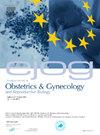年轻女性宫颈癌:年龄是否影响宫颈癌患者的生存?
IF 2.1
4区 医学
Q2 OBSTETRICS & GYNECOLOGY
European journal of obstetrics, gynecology, and reproductive biology
Pub Date : 2025-02-01
DOI:10.1016/j.ejogrb.2024.12.003
引用次数: 0
摘要
背景与目的:评价25岁及以下宫颈癌患者的肿瘤预后,并与老年患者进行比较。方法:回顾性分析宫颈癌患者,将其分为两组:年轻患者(≤25岁)和老年患者(≤25岁)。每位年轻患者从25岁以上宫颈癌患者数据库中选择两名对照,对照与FIGO分期、治疗和组织学类型相匹配。结果:共纳入138例患者,其中25岁以下46例,25岁以上92例。在年轻患者中,III期最常见,有21例(45.5%),而I、II和IV期分别有12例(26.2%)、8例(17.4%)和5例(10.9%)。5年RFS分别为75%和73%;P = 0.91)和5年OS(60%和67%;P = 0.45),组间差异无统计学意义。多因素分析后,年龄对OS无显著影响(HR 1.25, 95% CI 0.68-2.30;P = 0.46)或RFS (HR 0.95, 95% CI 0.43-2.10;p = 0.91)。结论:25岁及以下的宫颈癌患者的OS和RFS并不比25岁以上的患者差。本文章由计算机程序翻译,如有差异,请以英文原文为准。
Cervical cancer in young women: Does age impact survival in cervical cancer?
Background and objectives
To evaluate the oncology outcomes in cervical cancer patients aged 25 years or younger and compare them with those in older patients.
Methods
Cervical cancer patients were retrospectively analyzed and divided into two groups: young patients (≤25 years) and older patients (>25 years). For each young patient, two controls were selected from the database of cervical cancer patients aged over 25 years, matched by FIGO stage, treatment, and histologic type.
Results
A total of 138 patients were included, 46 patients aged 25 years or younger and 92 patients aged over 25 years. Of young patients, stage III was the most common, with 21 (45.5 %) patients, while stages I, II and IV occurred in 12 (26.2 %), 8 (17.4 %) and 5 (10.9 %) patients, respectively. The 5-year RFS (75 % and 73 %; P = 0.91) and 5-year OS (60 % and 67 %; P = 0.45) were not significantly different between the groups. After multivariate analysis age had no significant impact on OS (HR 1.25, 95 % CI 0.68–2.30; P = 0.46) or RFS (HR 0.95, 95 % CI 0.43–2.10; P = 0.91).
Conclusions
Cervical cancer patients aged 25 years or younger did not present a worse OS and RFS compared to patients aged over 25 years.
求助全文
通过发布文献求助,成功后即可免费获取论文全文。
去求助
来源期刊
CiteScore
4.60
自引率
3.80%
发文量
898
审稿时长
8.3 weeks
期刊介绍:
The European Journal of Obstetrics & Gynecology and Reproductive Biology is the leading general clinical journal covering the continent. It publishes peer reviewed original research articles, as well as a wide range of news, book reviews, biographical, historical and educational articles and a lively correspondence section. Fields covered include obstetrics, prenatal diagnosis, maternal-fetal medicine, perinatology, general gynecology, gynecologic oncology, uro-gynecology, reproductive medicine, infertility, reproductive endocrinology, sexual medicine and reproductive ethics. The European Journal of Obstetrics & Gynecology and Reproductive Biology provides a forum for scientific and clinical professional communication in obstetrics and gynecology throughout Europe and the world.

 求助内容:
求助内容: 应助结果提醒方式:
应助结果提醒方式:


